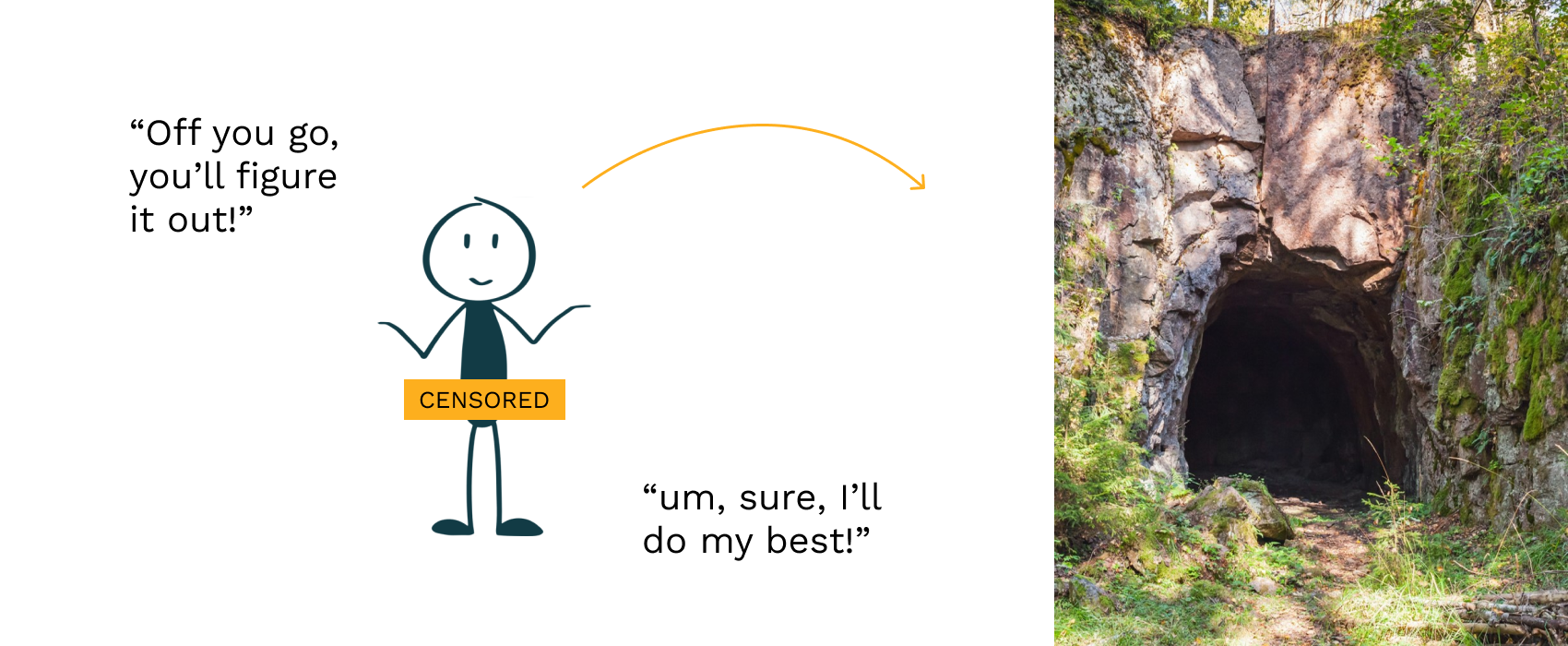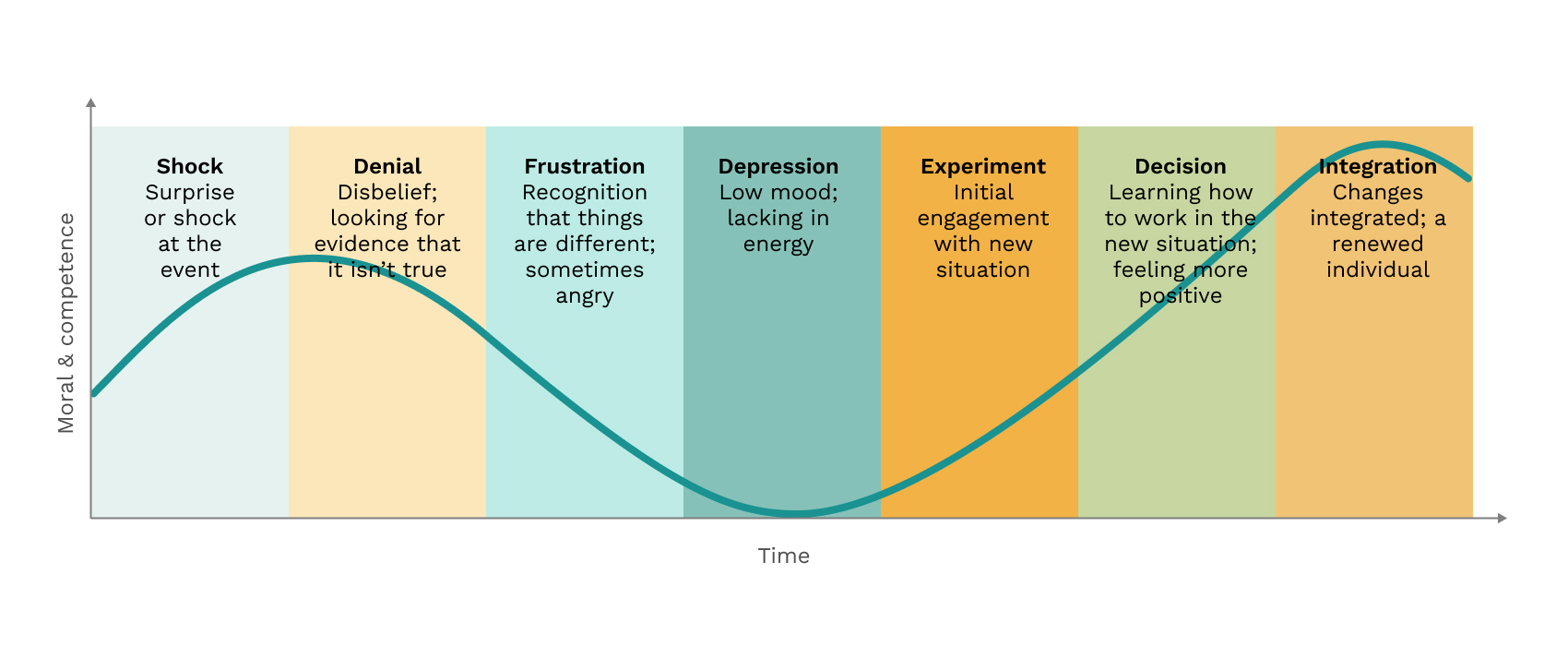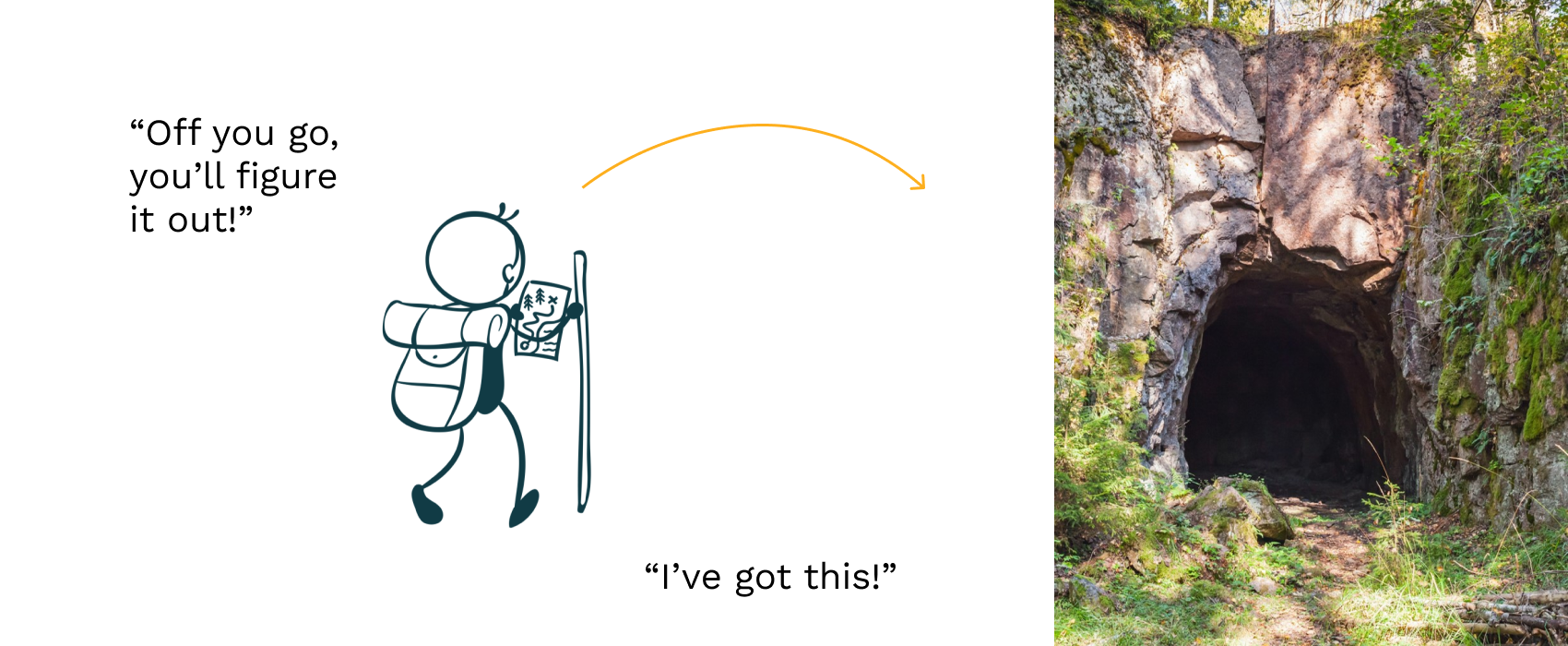If you work in service design or experience design, how do you talk about what you do? It's hard sometimes to explain; we research, we test, we redesign stuff. But really, what do we do?
What we do is chart our way through uncertainty – and that makes us like explorers. We never know what's in front of us and we need to figure it out. Uncertainty is everywhere; we're helping people through change and our clients through transformation.
To help make sense of the experience design process and what it’s like to navigate uncertainty, I want to share some tips and tricks I’ve learnt along the way through the lens of an explorer.
Well, in this case, I'm using one explorer: Loury Lag. He’s an extreme adventurer who does solo expeditions in the Arctic and Northwest Passage.
It’s been valuable for me to learn how he deals with uncertainty in his extreme world and draw parallels to my own work and experience.
Why are we so unsettled by uncertainty?
For Loury, his uncertainty is facing a great expanse of nothing. In documenting the beginning of one of his Arctic expeditions, he writes: “Here we are, with only one direction: straight ahead into the vast whiteness.”
As a species, our brain is biased toward certainty and knowing what will happen. That's how we have survived. We will observe a situation, create connections, predict what will happen, and then act.
But when you deal with complex problems and changing dynamics, it is harder for your brain to connect the dots and predict what will happen.
When we struggle with uncertainty, we often respond by worrying, focusing on risks and loss, and we tend to feel less confident in our ability to solve a problem. It's perfectly normal to feel uncomfortable when faced with uncertainty because that's how we are wired.
The explorer’s mindset
If you want to discover something new, if you are willing to learn something new, you will have to make the leap and lose sight of what feels comfortable. Because if you are grasping only what you know, then you will prevent yourself from exploration and from change. Loury writes:
“I have been taking quite a few risks for the past three days. With wind speeds of 60km/h, I decide to hoist my storm sail. The blizzard and the speed only allow me to see the obstacles at the last moment.
“But I don't mind, I have to make the most of this opportunity of favourable winds.”
That last sentence is amazing: “But I don't mind,” he says.
That’s the mindset and attitude that you need to develop as an explorer on your projects. But what does that look like in practice? What are the intrapersonal skills that you need to better deal with the unknown and build your resilience?
Here are my five tips and tricks for adopting a new mindset or shifting your attitude.
1. Feel comfortable being uncomfortable
You may have heard that you need to better understand your fears so you can tame them. As mentioned, it's normal to feel unsettled by uncertainty. Being vulnerable is part of the process, but when you understand why uncertainty is so daunting and can rationalise your feelings, then it is WAY easier to manage them, cool down and act.
2. Be curious
Curiosity is what drives you and enables you to move past your fears and doubts and just do it. If someone tells you “Do not open that door under any circumstances”, what are you going to do? To me, curiosity is an important factor of success because it acts as an incentive. The sense of reward from discovering something is grander than the potential risks you’ve identified. That attraction to unlocking mysteries is a big driver, and cultivating your curiosity will help you push your own boundaries.
3. Be flexible and adapt; accept change
Things will not go as planned; they simply never do despite our best efforts. That’s why someone who tends to be rigid, who wants things to be structured and organised as they imagine them, and likes keeping things under control is very likely to struggle and find the process highly stressful and frustrating.
Being organised and methodical is necessary, but the world is just not black and white. Things may happen that force you to re-assess the direction – and that’s OK! For any plan that you put together, be ready to consider and deploy plan B or C.
4. Kill the blah blah blah
You will gather lots of information and people will always have an opinion or feedback to share –meaning you will have a lot of noise to deal with. How do you cut the clutter?
You need to consider the information you have and remember that the opinions you hear are just assumptions unless you can validate them. I'm not saying disregard them, but consider the level of importance that you assign to opinions until you know they are worth paying attention to.
Focus on what is validated. Find the patterns and the data so you can concentrate on information that is reliable and trustworthy.
5. Reframe
Reframing is an important technique when times are uncertain. Remember, in these situations your natural tendency is to focus on risk and look at things as a threat. But for you to take advantage of the situation, why don’t you start thinking of positives and look for opportunities instead? Shift your mindset from the fear of loss to the anticipation of gain.
Re-consider how constraints, challenges, boundaries, and rules affect your thinking. What if they were simply obstacles to overcome or little puzzles to solve? Then by overcoming them, you realise that you can push your thinking, be free to innovate, and advance your project.
Rare are the people who possess these five qualities! Some are more gifted than others and are curious by nature, or more flexible by nature. But that doesn’t mean you can't work on it and grow these skills.
Now that we have identified these five areas of focus, proceed with a self-assessment and look to develop your weaker points.
Tools and techniques
For our friend Loury, he’s not just heading out onto the ice by himself – he has a pack full of equipment and tools that he takes with him. That's extremely important.
If you don't attribute importance to ongoing learning and development, it means that every time you face a project, you’re setting off without a useful toolkit.
Without experience and knowledge, it’s a bit like heading into a dark cave naked like a worm! Even though you have the right attitude, you’d get cold quickly, you won’t see anything, and you might hit your head because you don't have a helmet. Your chances of survival here are really low...

In times of uncertainty, remember you can never predict the future. So it's more important to know what to do than to know what is going to happen.
That's why tools and methodologies are so important. You need to prep and pack your gear for the journey ahead, and it starts by understanding what you can expect from your design adventure.
Understanding the design process
A big thing you have on your side is frameworks, and all the things that we use as experience designers to better understand, rationalise, and visualise what we do.
The Double Diamond model tells us that there are phases of divergence and convergence. When you diverge, it's more or less that phase of exploration – so you can anticipate that this is where you might not know what's going on and feel somewhat uncomfortable.
-1.png?width=1700&height=700&name=Page%2018-big%20(1)-1.png)
But I know that it will change because at some point we will converge and at that point, we will gain clarity. The problem with this model, while it’s very good and helpful, it doesn’t really explain what's happening internally.
This Design Squiggle model is better for that.

It still uses the same phases – research, concept, design – but it also visualises the confusion you may experience. Essentially, there’s a lot of mess in your mind until the concept phase, and then clarity emerges. Interestingly, when comparing this diagram with the Double Diamond, you realise that the messy phase goes for three-quarters of the Double Diamond process!
So, just to say, we are supposed to feel deep in the mud for most of the process. If it feels really hard for quite some time in your project, it will get better.
Lastly, I wanted to share one more model that shows the range of emotions that you will likely feel. Called the Kubler-Ross model, this isn’t design specific but has been created to explain how people react to change.

When facing sudden change, you may experience a range of wild emotions - shock, denial and frustration - before hitting rock bottom and longing for the things that you’ve lost. But then, as you start to work with the new situation and try to adapt to it (think of this moment as the concept phase), things start to improve. Overtime you start seeing some benefits and ultimately embrace that change.
Needless to say, our design process is quite a rollercoaster!
Planning your next adventure
Now you know at which stage you should be confused and when you should reach clarity, you can better plan your moves. The goal is not to plan how the story ends but rather break the design process into manageable chunks.
To make a good plan you need to assess the situation and start thinking about:
- What’s the terrain like? Am I in new territories? Or can I make some connections with a previous experience?
- What risks and opportunities do I identify in order to succeed?
- How long do I have to pull this off?
- Who can I count on?
Asking good questions and analysing the situation upfront will be key for you to decide which activities, methodologies and tools to use.
Should you use qualitative, quantitative data, or both? Should you use moderated or unmoderated techniques? Why?
Obviously, the more tools you try and the more you perform your craft, the easier it will become to select appropriate methods and be confident about your decisions. Ongoing training and development will turn you into the MacGyver of Design.
That's how you progress through the cave.
Don’t be reckless and naïve, but analyse and plan ahead, select your tools, and know when and how to use them. It's about shifting away from making inconsiderate moves to making calculated moves.
Building a supportive ecosystem
Loury is a solo adventurer and even though he may be by himself during an expedition, he has a team of people that helped him prep, and follow up his progress, ready to intervene if needed. Like Loury, you need to surround yourself with the right people and build a supportive ecosystem.
There are two things that we are looking for when considering a supportive ecosystem – the external and the internal.
The external are subject matter experts, the stakeholders or clients. It's very important that you tap into those people because you will go into an alien environment with loads of uncertainty.
No-one can know everything all the time, so tap into the knowledge that these subject matter experts may have, that your clients may have, to start compensating for the gap in knowledge.
Ultimately, they will become your partners and they will want to see it succeed, just like you. That means that you are turning them into advocates that can help get wider buy-in, which is critical to the success of a project.
So that’s external. The internal relates to, unsurprisingly, your team.
You need to surround yourself with people that are more clever than you. You need to understand your strengths and, more importantly, your weaknesses and how you can compensate that with other beautiful minds and beautiful skills.
This leans into unlocking innovation in a team. When you're building a team made up of people who have different ways of thinking, you’ll be able to come up with a lot more ideas and solutions. That's when you unlock that innovation and that potential that you would never have been able to do by yourself.
It also means you can share the mental load and feel less pressure and anxiety. The only way to do this in a healthy, productive, and successful way is if you create psychological safety. That means making sure you create an environment that enables team support and trust. People in your team should feel like they have permission to experiment and take risks together. The journey will not only be more rewarding but it will also be more fun!
Off you go!

And here you are! Earlier, you were naked and ill equipped to enter the dark cave – but look at you!
You have a plan, you have a map, you can defend yourself, you have tools, the experience and the attitude. And if anything happens, you know you can count on people you trust – you've got this, it's fine.
So before you set off, here is a recap of what you will need if you want to become a fearless explorer:
- Normalise uncertainty and its effects. The ultimate trick to fight against your primal instincts
- Develop the right mindset and attitude. Be vulnerable, improvise, and take calculated risks to reap the rewards
- Plan ahead. Analyse your terrain and how to approach it. Consider fallback plans. Just because the journey is uncertain, it should never be an excuse to not plan
- Keep learning new techniques. Each tool has pros and cons, so the more you know, the easier it will become to adapt to any situation
- Join forces. Share the load and the knowledge with your team and stakeholders. Your work will be more streamlined, fit for purpose, and fun!